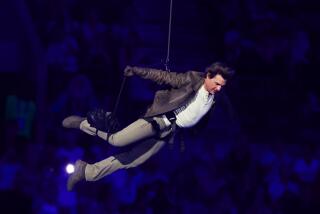A TRIBUTE TO THAT THIN MAN WITH THE TOP HAT AND TAILS
“Searching out Fred Astaire movies in some revivalist theater used to be a sleuth’s work,” says John Mueller, author of the recently published “Astaire Dancing” (Knopf: $45). “But now there seems to be a video store on every other corner and it’s easy to rent the films he made. Thanks to the VCR explosion, everyone can experience Astaire the artist through his own medium: film.”
For dance, which has no other functional record such as a manuscript or a score, film and videotape are the end-all and be-all. Thus, to Mueller, the advent of cable television and videocassettes has kept today’s public current with films from 40 years ago.
Mueller, here visiting his family in North Hollywood (where he grew up), teaches political science and dance history at the University of Rochester. Even though he only discovered dance as an art form a decade and a half ago--when he saw New York City Ballet in nearby Saratoga--he has become a recognized authority on film dance.
“Before Balanchine, I just couldn’t take dance seriously,” Mueller says. “It was a discipline that seemed unlinked to a context, like reading a dictionary without ever encountering a novel or playing scales but never hearing a piece of music.”
He discovered Astaire soon after and, launching into intense study of the dancer’s Hollywood musicals, developed a course and lecture series on the subject that he has taken on tour around the world.
In lionizing Astaire’s dancing, Mueller joins George Balanchine, Mikhail Baryshnikov, Rudolph Nureyev, Merce Cunningham, Carmelita Maracci, Arlene Croce and countless other dance pundits who regard the thin man in the top hat as an artist of highest merit. Mueller is quick to argue that although the unschooled may think Astaire’s dances are improvised and even believe that his current popularity depends on nostalgia, neither could be further from the truth.
“Every step he took was painstakingly worked out,” Mueller says. “But Astaire once told me that he could explain golf easier than choreography. And I can see that his basic tack was instinct, not analysis.”
He rejects the idea that people today are compelled by the seeming innocence and simple virtues depicted in old Astaire films. “I contend that the proof of an artwork is whether it bears repeated scrutiny, whether new things can be learned with each exposure. Obviously, Astaire’s output passes the test.”
In discussing the “Cheek to Cheek” duet from “Top Hat,” Mueller clarifies how this “seduction dance” expresses “the gradual breaking down of (Ginger) Rogers’ resistance through the progressive back bends--each one gets lower and lower.”
What Mueller emphasizes both in his lively conversation and the book--a 440-page tome that contains, in addition to hundreds of movie frames, appraisals of all production aspects and exhaustive, scholarly notations on every dance in every Astaire film--is the choreography’s expressive intricacy and originality.
Agnes de Mille is commonly credited with creating the first plot-integrated dance in a musical: the dream ballet in “Oklahoma!” (1943). But Mueller contends that Astaire “crafted dramatically eventful dances” well before De Mille’s achievement--and before 1936, the year Balanchine made the “Slaughter on Tenth Avenue” ballet for “On Your Toes.”
“Astaire worked hard not to repeat himself,” says Mueller, “and he didn’t confine his interest just to the dances. Often he collaborated with the composers and lyricists. No one on the production team, from his partner to the scriptwriter or editor, would be surprised to get a phone call from him in the middle of the night because of a sudden inspiration on how to solve this or that problem.
“What few realize is that he custom-tailored his dances to each partner. Ginger Rogers had the most supple of backs, so he capitalized on deep backbends with her. His duets with Cyd Charisse and Vera-Ellen emphasized their balletic extensions and space-devouring approach.”
Astaire used what he called an “outlaw style,” a combination of tap and ballroom, but seldom borrowed from the vocabularies of ballet, modern, Latin or jazz. Neither did he stray far from the vein of romantic comedy, although the sweeping ardor in many of the dances with Rogers certainly transcends that genre, Mueller says.
In fact, Mueller finds that Astaire’s dancing persona epitomizes the elegance, sophistication, wit and tenderness belonging to him alone. It inspired a book by Croce several years ago and it distinguishes the dancer, as romantic hero, from such macho cinematic ideals as Gary Cooper and Clark Gable.
But the times reflect changing values, and who can find any semblance of those old ideals on screen today? Mueller recounts a conversation with Astaire in which the dancer talked about the sexual implications of his celluloid romances.
“It was interesting,” he says, “to hear him complain about how obvious today’s screen lovers are. He found the gratuitous nudity and graphic sex insensitive and one-dimensional.”
But it was not this change in mores that marked the end of Astaire’s career in movie musicals, according to Mueller. Rather, he faults a “cinematizing” of dance, as seen in “Finian’s Rainbow,” which Astaire openly called “a big disappointment.” Directed by Francis Coppola in 1968, this picture was the first one to do away with careful editing of choreography and in its place resort to fragmentation and nervous camera techniques that keep jumping away from the dance.
“In Fred Astaire’s terms,” Mueller says, “the glory that was Hollywood ceased to exist.”
More to Read
The biggest entertainment stories
Get our big stories about Hollywood, film, television, music, arts, culture and more right in your inbox as soon as they publish.
You may occasionally receive promotional content from the Los Angeles Times.










